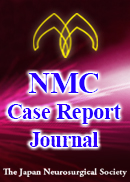Volume 4, Issue 4
Displaying 1-8 of 8 articles from this issue
- |<
- <
- 1
- >
- >|
Case Reports
-
2017 Volume 4 Issue 4 Pages 97-99
Published: 2017
Released on J-STAGE: October 01, 2017
Advance online publication: August 23, 2017Download PDF (1962K) Full view HTML -
2017 Volume 4 Issue 4 Pages 101-105
Published: 2017
Released on J-STAGE: October 01, 2017
Advance online publication: September 07, 2017Download PDF (2808K) Full view HTML -
2017 Volume 4 Issue 4 Pages 107-110
Published: 2017
Released on J-STAGE: October 01, 2017
Advance online publication: August 23, 2017Download PDF (2296K) Full view HTML -
2017 Volume 4 Issue 4 Pages 111-113
Published: 2017
Released on J-STAGE: October 01, 2017
Advance online publication: August 24, 2017Download PDF (3068K) Full view HTML -
2017 Volume 4 Issue 4 Pages 115-120
Published: 2017
Released on J-STAGE: October 01, 2017
Advance online publication: September 12, 2017Download PDF (3596K) Full view HTML -
2017 Volume 4 Issue 4 Pages 121-125
Published: 2017
Released on J-STAGE: October 01, 2017
Advance online publication: September 15, 2017Download PDF (3658K) Full view HTML -
2017 Volume 4 Issue 4 Pages 127-130
Published: 2017
Released on J-STAGE: October 01, 2017
Advance online publication: September 11, 2017Download PDF (3351K) Full view HTML
Editorial Committee
-
2017 Volume 4 Issue 4 Pages EC7-EC8
Published: 2017
Released on J-STAGE: October 01, 2017
Download PDF (872K)
- |<
- <
- 1
- >
- >|
